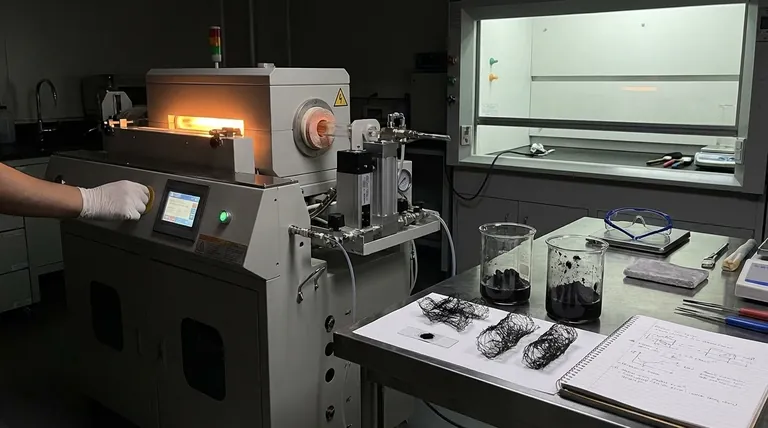The primary drawbacks of nanotubes are significant challenges in their production, high costs, potential toxicity, and extreme difficulty in getting them to disperse uniformly into other materials. While their theoretical properties are revolutionary, these practical hurdles currently limit their widespread, real-world application.
The core issue with nanotubes is the profound gap between their remarkable potential on a microscopic scale and the difficulty of producing and handling them reliably and safely on a macroscopic scale.

The Core Challenge: Production and Control
The foundational problems with nanotubes begin at the moment of their creation. The methods used to synthesize them are complex and often lack the precise control needed for consistent, high-quality output.
Achieving High Purity
Most synthesis methods, like arc discharge or laser ablation, produce a raw material that contains significant impurities. This soot includes amorphous carbon and unwanted catalyst particles, which must be removed through harsh purification processes that can damage the nanotubes themselves.
Controlling Physical Structure
The properties of a carbon nanotube are dictated by its chirality—the specific angle of its atomic lattice. This determines if it behaves as a metal or a semiconductor. Current production methods create a mix of different chiralities, and separating them is an incredibly difficult and expensive task.
Scalability and Cost
Traditional methods often rely on high-temperature and high-pressure conditions, making the process energy-intensive and complex. Scaling this production to industrial levels while maintaining quality and keeping costs competitive with existing materials remains a major economic barrier.
Practical Hurdles in Application
Even if you obtain high-quality nanotubes, integrating them into a final product presents its own set of formidable challenges.
The Dispersion Dilemma
Due to powerful van der Waals forces, individual nanotubes have an extremely strong tendency to clump together, forming tangled bundles. This aggregation prevents their incredible strength and conductivity from being transferred to the host material (like a polymer or ceramic), negating their primary benefit.
Interfacial Bonding Issues
For nanotubes to reinforce a material, they must form a strong bond with the surrounding matrix. A weak interface means that when stress is applied, the nanotubes will simply pull out rather than share the load. Achieving this strong bond often requires complex and costly surface treatments.
Understanding the Trade-offs: Health and Environmental Concerns
The unique physical properties of nanotubes also raise valid questions about their safety, creating a significant hurdle for applications in medicine and consumer goods.
The Toxicity Question
The needle-like shape of some nanotubes is structurally similar to asbestos fibers, raising concerns that they could cause similar damage to lung tissue if inhaled. While research is ongoing, this potential biopersistence and inflammatory response creates regulatory and public perception challenges.
Environmental Impact
The full lifecycle impact of nanotubes is not yet fully understood. Questions remain about how they break down in the environment and what potential long-term ecological effects their widespread use might have. This uncertainty complicates risk assessment for large-scale deployment.
Making the Right Choice for Your Goal
Navigating these drawbacks requires aligning your strategy with your primary objective.
- If your primary focus is academic research: Accept material inconsistency as a variable and focus on characterizing the specific nanotubes you have to explore fundamental properties.
- If your primary focus is industrial composites: Prioritize developing a robust and repeatable dispersion process, as this is the single greatest factor in unlocking the material's performance.
- If your primary focus is biomedical applications: Proceed with extreme caution, emphasizing biocompatibility testing and surface functionalization to mitigate potential toxicity risks from the outset.
Successfully leveraging nanotubes today is less about their theoretical perfection and more about engineering intelligent solutions to their practical flaws.
Summary Table:
| Drawback Category | Key Challenges | Impact on Application |
|---|---|---|
| Production & Control | Impurities, inconsistent chirality, high energy costs | Limits quality, scalability, and economic viability |
| Practical Application | Poor dispersion, weak interfacial bonding | Negates strength/conductivity benefits in composites |
| Health & Environment | Potential toxicity similar to asbestos, unknown ecological impact | Creates regulatory and safety hurdles for medical/consumer use |
Ready to overcome material challenges in your lab?
Navigating the complexities of advanced materials like nanotubes requires reliable equipment and expert support. At KINTEK, we specialize in providing high-quality lab equipment and consumables tailored to your research and development needs. Whether you're working on dispersion techniques, purification processes, or safety protocols, we have the tools to help you succeed.
Let's innovate together. Contact our experts today to find the right solutions for your laboratory challenges.
Visual Guide

Related Products
- Customer Made Versatile CVD Tube Furnace Chemical Vapor Deposition Chamber System Equipment
- Chemical Vapor Deposition CVD Equipment System Chamber Slide PECVD Tube Furnace with Liquid Gasifier PECVD Machine
- RF PECVD System Radio Frequency Plasma-Enhanced Chemical Vapor Deposition RF PECVD
- Inclined Rotary Plasma Enhanced Chemical Vapor Deposition PECVD Equipment Tube Furnace Machine
- 1200℃ Split Tube Furnace with Quartz Tube Laboratory Tubular Furnace
People Also Ask
- What is the floating catalyst method? A Guide to High-Yield CNT Production
- What is a CVD tube furnace? A Complete Guide to Thin-Film Deposition
- How high of temperature do carbon nanotubes in air have the ability to sustain? Understanding the Oxidation Limit
- Why are carbon nanotubes important in industry? Unlocking Next-Generation Material Performance
- How does chirality affect carbon nanotubes? It Determines If They Are Metal or Semiconductor



















